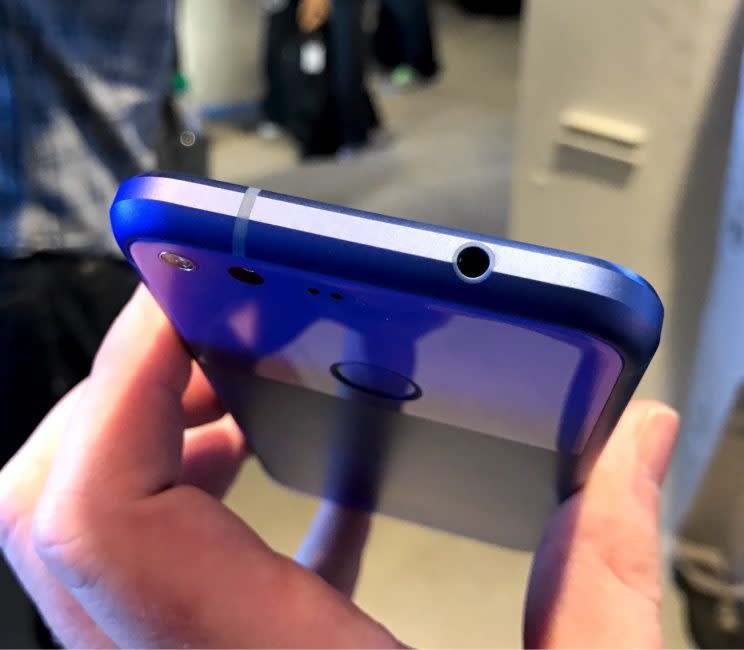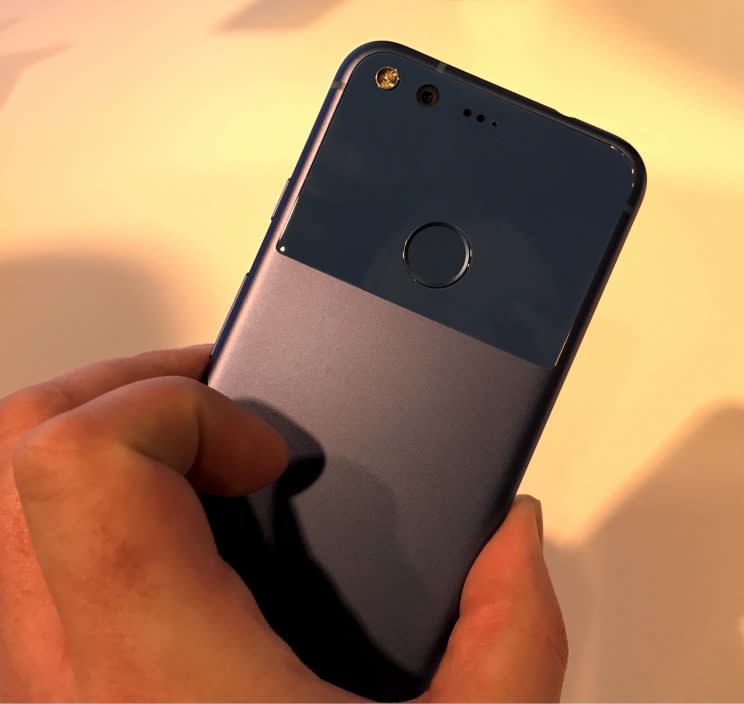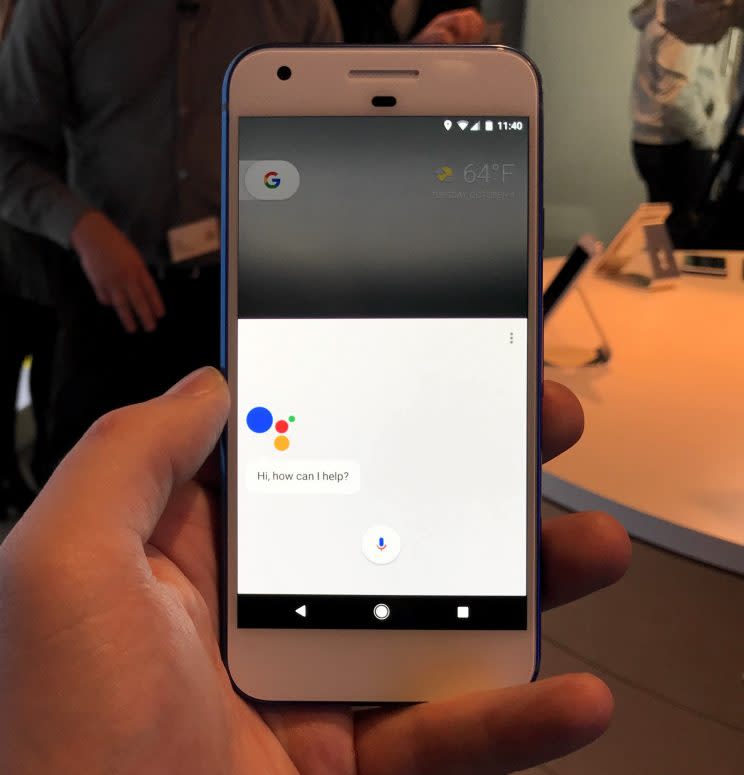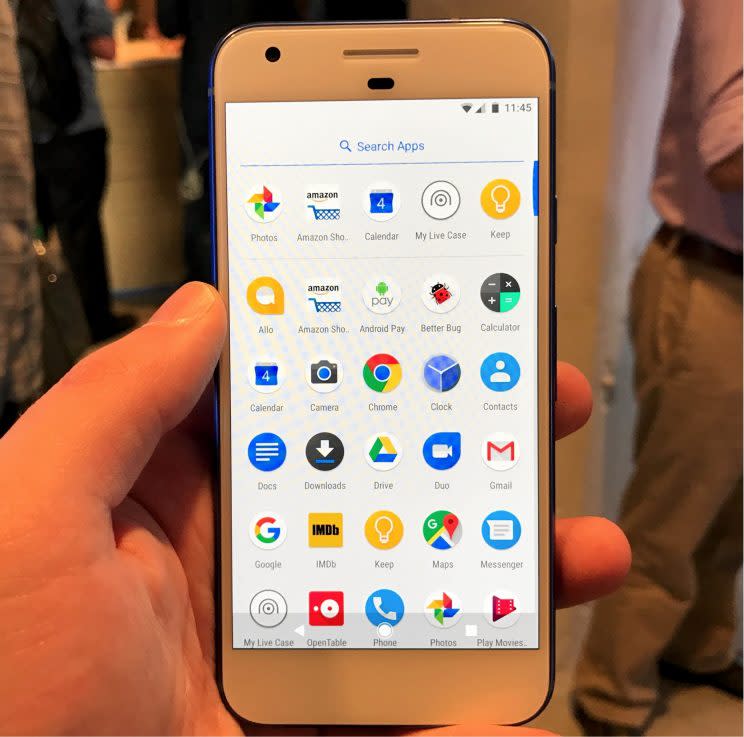I got my hands on Google's Pixel phone, and it was legit
Google (GOOG, GOOGL) has always been a bit of a backseat driver when it comes to Android smartphones. Sure, the tech giant sold its own line of Nexus phones, but they were largely meant as blueprints to show partners like Samsung, LG and HTC how Android phones could look and function.
Now Google is hopping into the driver’s seat on its own with its new 5-inch Pixel and 5.5-inch Pixel XL smartphones. And it’s heading straight toward the market leader: Apple’s (AAPL) iPhone.
Developed and designed by Google, the phones are an extension of the Big G from top to bottom. Yes, these particular handsets were built by HTC, just as Nexus devices were built by LG, Huawei and others in the past. But HTC gets no top billing for its hand in the Pixel’s creation. Its name doesn’t even appear on the phone.
That’s because these phones are all Google and the company wants you to know exactly that, starting with the “G” logo on the handset’s back panel.
I spent some time with the Pixel and Pixel XL following their unveiling in San Francisco on Tuesday, and I liked what I saw. Let’s start with the phones’ designs.
Design
The biggest difference between the Pixel and Pixel XL is their screen size. In fact, that’s their only real difference. Both phones are built with aluminum bodies that feature small glass coated areas along the top of their rear panels. It’s a nice look, but that glass sure does pick up fingerprints fast. Then again, so does the polished back of the jet-black iPhone 7 and any of Samsung’s recent phones.
Neither Pixel has a physical Home button. Instead, you get a virtual on-screen Home button, as well as recent apps and the standard Android back button. On the phones’ right sides you’ll find their volume rockers and their power buttons. Around back are their fingerprint readers.

I’ll be perfectly honest; I’m a big fan of the fingerprint reader on the back of phones. It’s much easier to reach than a reader on the front of your device, and you don’t risk dropping it when you inevitably have to readjust your hand to reach the reader.
For Google’s first big foray into handset design, I’m not exactly impressed. Sure the Pixel and Pixel XL are attractive enough. But they aren’t nearly as elegant or premium looking as Apple’s iPhone or Samsung’s Galaxy S7. The Pixel just looks kind of, well, plain.
Of course, it could be argued that it doesn’t matter what your phone looks like since it will inevitably be wrapped in a protective case. But I’d still rather know that I could take that case off and have a beautiful piece of technology hiding underneath. It’s worth noting the Pixels come in silver, black and blue color options. But you’re going to have to wait for the blue version, as it’s already sold out.
As far as the Pixel and Pixel XL’s displays go, the Pixel gets a 5-inch, 1080p, AMOLED screen, while the Pixel XL gets a 5.5-inch QHD AMOLED panel. It would have been nice to see the Pixel get a similarly high-resolution display considering Google wants you to use both of these phones with its Daydream virtual reality headset. That’s because the closer you bring the phone to your face, the more you’re able to see its pixels. If your phone is jam-packed with pixels, though, it’s harder to see them.
That said, both phones offered brilliant visual fidelity when I tried them during my hands-on time. Text looked crisp and colors were bright and vibrant.

Oh, and just in case you’re wondering: Both Pixels come with 3.5mm headphone jacks, a point Google was sure to make as a dig at Apple’s decision to kill the port on its iPhone 7 and iPhone 7 Plus.
Those cameras
That headphone jack wasn’t the only bit of needling Google aimed at Apple, though. The company also claims the Pixel and Pixel XL have the best smartphone cameras on the market. That’s a rather lofty claim considering the iPhone 7 and 7 Plus and Samsung’s Galaxy S7 and Note 7 all have amazing shooters.
Google, of course, was also quick to point out the Pixels also lack “unsightly” camera bumps, which again, is a shot at Apple.
According to Google, the Pixel and Pixel XL’s 12-megapixel cameras receive the highest ratings by independent camera tester DxOMark. Both cameras also offer optical image stabilization. Google’s Nexus phones have always had middling cameras that could never quite match up to what Apple or Samsung had to offer, but it looks like Google is genuinely trying to take on its competitors — and in Samsung’s case, partner — with the Pixel and Pixel XL.

I was only able to use the Pixel and Pixel XL’s cameras during the quick hands-on time available following Google’s announcement, so I can’t make any definitive statements as to their capabilities. But I can say I was impressed with how quickly they fire off shots. That’s especially intriguing when you consider the Pixel and Pixel XL always use HDR mode, a feature that traditionally slows down most smartphone cameras.
Google Assistant
Part of the reason Google is rolling out these two new handsets is that they are the first to get the company’s new Google Assistant voice and text-activated AI built right in.
Accessible by long-pressing the Pixel or Pixel XL’s Home buttons, Assistant lets you do things like ask Google how to get to a specific restaurant, book a reservation there and call an Uber without having to open another app. Assistant can also control other devices like your Chromecast, smart home appliances such as connected lights and thermostats, find specific photos in Google Photos and give you a look at your day ahead.

I used Google Assistant during my review of Google’s Allo messaging app and it was a seriously slick piece of software. The scope of what Google is trying to put together with Assistant is staggering when you think about it. The company is literally trying to boil down all of its disparate services into a single app that’s accessible from your handset.
Assistant can also access your Gmail, so if you received a flight confirmation email last week and want to know what time your flight leaves today, you can ask Assistant “When does my flight leave?” and it will automatically pull up your flight information.
Android 7.0 Nougat
Both the Pixel and Pixel XL will launch with the latest version of Google’s Android operating system: Android 7.0 Nougat. The software brings a rather large and welcome visual overhaul to Android complete with new icon designs and a new way to access your apps.
Rather than having a traditional apps drawer that you can get to by tapping the apps drawer button, you now swipe up from the bottom of the screen to pull up all of your apps. It’s a nice change that gives Android a slightly more cohesive feel.

One of my favorite features that Google brought to Android 7.0 on the Pixel and Pixel XL is a new way to open the notifications shade and quick settings menu. Normally, you’d have to swipe down from the top of the screen to get your notifications and then swipe down again to get your quick settings.
With the Pixel and Pixel XL, you can actually swipe down on the fingerprint reader on the back of the phones to bring up the notifications shade. Swipe again, and there is your quick settings menu. It’s a small update, but if you’re using your phone with one hand, it could be incredibly helpful.
The power
The Pixel and Pixel XL both sport quad-core processors — Qualcomm Snapdragon 821 chips, if you’re a nerd like me. Add to that 4GB of RAM and these phones absolutely fly. In terms of storage, the handsets come in 32GB and 128GB varieties.
Charging comes by way of USB-C ports, so say goodbye to your old microUSB charger. The Pixel comes with a 2,770-mAh battery, while the Pixel XL gets a 3,450-mAh power plant. I can’t say how well the batteries will perform with any specificity, but Google says you’ll be able to give them 7 hours of power with a quick 15-minute charge.
Getting your Google on
The Pixel and Pixel XL are available for pre-order right now. If you were a fan of Google’s Nexus phones, though, this is where your jaw hits the floor. Whereas the Nexus handsets were meant to be affordable, the Pixel and Pixel XL carry premium prices. The 32GB Pixel starts at $650, while the 128GB Pixel costs $750. A 32GB Pixel XL, meanwhile, costs $770 and the 128GB Pixel XL costs $870. That’s a lot of cash for a Google phone.
In a surprising move, the Pixel and Pixel XL will be Verizon exclusive devices, though you’ll be able to buy them unlocked through the Google Store.
If you’re switching from an iPhone to the Pixel, though, Google makes it nice and easy with a new switcher app, which makes three shots at Apple. Man, Google is vicious.
So should you pre-order the Pixel and Pixel XL. So far they look like pretty solid devices, but I’m still going to need to get my hands on them for longer than 20 minutes to give you a firm recommendation either way. Stay tuned.
More from Google’s keynote:
Google’s Daydream solves a big problem with other VR headsets
Google unveils its new Pixel phones while making a dig at Apple
Email Daniel at [email protected]; follow him on Twitter at @DanielHowley.
